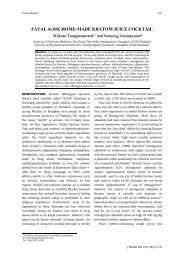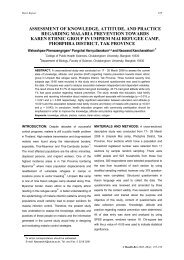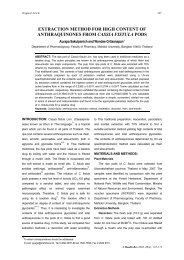antityrosinase and antibacterial activities of mangosteen pericarp
antityrosinase and antibacterial activities of mangosteen pericarp
antityrosinase and antibacterial activities of mangosteen pericarp
Create successful ePaper yourself
Turn your PDF publications into a flip-book with our unique Google optimized e-Paper software.
Original Article 99<br />
ANTITYROSINASE AND ANTIBACTERIAL ACTIVITIES OF<br />
MANGOSTEEN PERICARP EXTRACT<br />
Sarin Tadtong 1,∗ , Amornrat Viriyaroj 1 , Suwanna Vorarat 1 , Sathaporn Nimkulrat 1<br />
<strong>and</strong> Sunit Suksamrarn 2<br />
1Faculty <strong>of</strong> Pharmacy, Srinakharinwirot University, Nakhonnayok 26120, Thail<strong>and</strong><br />
2Faculty <strong>of</strong> Science, Srinakharinwirot University, Bangkok 10110, Thail<strong>and</strong><br />
ABSTRACT: The objective <strong>of</strong> this study is to determine the tyrosinase inhibition <strong>and</strong><br />
<strong>antibacterial</strong> <strong>activities</strong> against the pathogenic bacteria in the oral cavity <strong>of</strong> the <strong>mangosteen</strong><br />
<strong>pericarp</strong> extract. The results showed that the <strong>mangosteen</strong> <strong>pericarp</strong> extract inhibited the<br />
tyrosinase enzyme at IC50 = 67 ng/ml. Furthermore, the <strong>mangosteen</strong> <strong>pericarp</strong> extract also<br />
exhibited the <strong>antibacterial</strong> <strong>activities</strong> against the pathogenic bacteria in the oral cavity,<br />
Streptococcus mutans DMST18777, Porphyromonas gingivalis DMST2136, <strong>and</strong> Streptococcus<br />
pyogenes DMST17020 at minimal inhibitory concentration (MIC) <strong>of</strong> 0.01 mg/ml, <strong>and</strong><br />
Staphylococcus aureus ATCC25923 at MIC <strong>of</strong> 0.1 mg/ml by agar dilution method.<br />
Keywords: Garcinia mangostana, <strong>antityrosinase</strong>, antimicrobial, agar dilution method<br />
INTRODUCTION: Mangosteen (Garcinia mangostana<br />
Linn, Guttiferae) is the plant mostly found in<br />
Asia, especially in Thail<strong>and</strong>. The <strong>pericarp</strong> <strong>of</strong> this<br />
plant has been used as a medicinal agent in<br />
Southeast Asia for the treatment <strong>of</strong> skin infections<br />
<strong>and</strong> wounds, inflammation, <strong>and</strong> diarrhea. Its<br />
<strong>pericarp</strong> contains a variety <strong>of</strong> xanthones, such as<br />
α-, β-, γ-mangostins which have remarkable<br />
biological <strong>activities</strong>. The biological <strong>activities</strong> <strong>of</strong><br />
xanthones isolated from <strong>mangosteen</strong> include<br />
antioxidant, antitumoral, <strong>antibacterial</strong>, antiviral,<br />
antifungal, antiallergic, <strong>and</strong> anti-inflammatory<br />
properties. The <strong>antibacterial</strong> activity against<br />
Staphylococcus aureus, methicillin-resistant<br />
Staphylococcus aureus (MRSA), Staphylococcus<br />
epidermidis, Bacillus subtillis, Propionibacterium<br />
acnes, Pseudomonas aeruginosa, Salmonella<br />
enteritidis, Salmonella thyphimurium, Proteus sp.,<br />
Klebsiella sp., Escherichia coli, Enterococcus spp.,<br />
<strong>and</strong> vancomycin resistant Enterococci (VRE) <strong>of</strong> the<br />
<strong>mangosteen</strong> has been reported1) . However, the<br />
<strong>antityrosinase</strong> <strong>and</strong> <strong>antibacterial</strong> <strong>activities</strong> against<br />
the pathogenic bacteria in the oral cavity have not<br />
been reported. Thus, the purpose <strong>of</strong> this study is<br />
to determine the tyrosinase inhibition <strong>and</strong><br />
<strong>antibacterial</strong> <strong>activities</strong> against the pathogenic<br />
bacteria in the oral cavity <strong>of</strong> the <strong>mangosteen</strong><br />
<strong>pericarp</strong> extract.<br />
MATERIALS AND METHODS:<br />
Plant materials <strong>and</strong> extraction method<br />
∗ To whom correspondence should be addressed.<br />
E-mail: sarin@swu.ac.th<br />
Tel. +66 2664 1000, Fax. +66 9739 5096<br />
The <strong>pericarp</strong> <strong>of</strong> <strong>mangosteen</strong> was collected from<br />
Kombang district, Chanthaburi Province,<br />
Thail<strong>and</strong> in April 2006. Air dried <strong>and</strong> powdered <strong>of</strong><br />
G. mangostana (0.5 kg) was thoroughly extracted<br />
with ethyl acetate at 50oC for 48 h. The combined<br />
extracts were concentrated in vacuo to give crude<br />
extract (41 g) which stored at room temperature.<br />
Mangosteen <strong>pericarp</strong> extract-PVP complex<br />
Due the solubilities <strong>of</strong> <strong>mangosteen</strong> <strong>pericarp</strong><br />
extract in the water <strong>and</strong> buffer were very low, the<br />
complex between Polyvinylpyrolidone MW 40,000<br />
(PVP K30) (Fluka, USA) <strong>and</strong> the <strong>mangosteen</strong><br />
<strong>pericarp</strong> extract was made. The complex between<br />
<strong>mangosteen</strong> <strong>pericarp</strong> extract <strong>and</strong> PVP K30 was<br />
performed by modifying the method as described<br />
earlier2) . In brief, the <strong>mangosteen</strong> <strong>pericarp</strong> extract<br />
was dissolved in methanol (Labscan, Thail<strong>and</strong>)<br />
<strong>and</strong> then slowly poured into the solution <strong>of</strong> PVP in<br />
methanol in the ratio 1:1. The organic solvent was<br />
completely removed under vacuum to yield the<br />
<strong>mangosteen</strong> <strong>pericarp</strong> extract-PVP complex (MPC).<br />
HPLC Analysis for α-mangostin content<br />
The α-mangostin content in the <strong>mangosteen</strong><br />
<strong>pericarp</strong> extract was analyzed by HPLC. The<br />
<strong>mangosteen</strong> <strong>pericarp</strong> extract <strong>and</strong> MPC were<br />
dissolved in methanol (1 mg/ml). The sample was<br />
injected into a C-18 column (Hypersil BDS, 25 cm<br />
X 4.6 micron) (Thermo Sciencetific, Engl<strong>and</strong>),<br />
using a Perkin Elmer HPLC system with a UV<br />
spectrophotometer detector. The mobile phase<br />
J Health Res 2009, 23(2): 99-102
100 Original Article<br />
was run in isocratic fashion <strong>of</strong> 6% water in MeOH<br />
at flow rate <strong>of</strong> 1 ml/mim. The α-mangostin was<br />
detected at wavelength <strong>of</strong> 319 nm3) . The st<strong>and</strong>ard<br />
α-mangostin (>98 % purity) was dissolved in<br />
methanol to make a stock solution at<br />
concentration <strong>of</strong> 0.1 mg/ml. The stock solution<br />
was further diluted with methanol to make the<br />
st<strong>and</strong>ard concentrations <strong>of</strong> 20 μg/ml, 40 μg/ml,<br />
60 μg/ml, <strong>and</strong> 80 μg/ml. The st<strong>and</strong>ard curve <strong>of</strong><br />
α-mangostin was plotted between peak area ratio<br />
<strong>and</strong> concentration.<br />
Antityrosinase Assay<br />
Chemicals<br />
DL-DOPA, mushroom tyrosinase (T3824-<br />
25KU) <strong>and</strong> kojic acid were purchased from Sigma<br />
(USA).<br />
Inhibition <strong>of</strong> tyrosinase activity<br />
Tyrosinase activity inhibition was determined<br />
by the method as described earlier4) . In brief, MPC<br />
was dissolved in 95% ethanol to make the stock<br />
solutions at concentrations <strong>of</strong> 0.2, 0.02, 0.002,<br />
0.0002, <strong>and</strong> 0.00002 mg/ml, respectively. The<br />
96-well plate was prepared by applying 140 μl <strong>of</strong><br />
phosphate buffer pH 6.8, 20 μl <strong>of</strong> tyrosinase (48<br />
units/ml), 20 μl <strong>of</strong> sample, <strong>and</strong> 20 μl <strong>of</strong> 0.85 mM<br />
DL-DOPA to make the test concentrations <strong>of</strong> MPC<br />
at 0.01, 0.001, 0.0001, 0.00001, <strong>and</strong> 0.000001<br />
mg/ml, respectively. After incubation for 10<br />
minutes, the enzyme activity was determined by<br />
measuring the absorbance at 492 nm using the<br />
microplate reader (Anthos, Zenith 200rt)<br />
comparing to the control consisting <strong>of</strong> 95%<br />
ethanol instead <strong>of</strong> sample. Kojic acid (1 mg/ml)<br />
was used as positive control. Three independent<br />
experiments were performed <strong>and</strong> each experiment<br />
was run in triplicate. The percentage <strong>of</strong> tyrosinase<br />
inhibition was calculated as follows:<br />
%inhibition = (Acontrol-Ablank)-(Asample-AblankS) x 100<br />
(Acontrol-Ablank)<br />
Acontrol= Absorbance at 492 nm <strong>of</strong> the solution<br />
without sample but consisted <strong>of</strong> enzyme<br />
Ablank= Absorbance at 492 nm <strong>of</strong> the solution<br />
without sample <strong>and</strong> enzyme<br />
Asample= Absorbance at 492 nm <strong>of</strong> the solution<br />
with sample <strong>and</strong> enzyme<br />
AblankS= Absorbance at 492 nm <strong>of</strong> the solution<br />
without enzyme but consisted <strong>of</strong> sample<br />
J Health Res 2009, 23(2): 99-102<br />
Antibacterial assay<br />
Test organisms<br />
The bacterial strains used were Streptococcus<br />
pyogenes DMST17020, Staphylococcus aureus<br />
ATCC25923, Streptococcus mutans DMST18777,<br />
<strong>and</strong> Porphyromonas gingivalis DMST2136. All the<br />
bacteria were obtained from Thail<strong>and</strong> National<br />
Institutes <strong>of</strong> Health.<br />
All bacteria except P. gingivalis DMST2136<br />
were cultured on Tryptic soy agar (TSA) at 37°C<br />
for 24 h prior to use. The P. gingivalis DMST2136<br />
was cultured on Brucella agar with vitamin K <strong>and</strong><br />
hemin (BCA) at 37°C in anaerobic atmosphere for<br />
120 h prior to use.<br />
Chemicals<br />
Tryptic soy agar (TSA) <strong>and</strong> Brucella agar with<br />
vitamin K <strong>and</strong> hemin (BCA) were purchased from<br />
DifcoTM (USA) <strong>and</strong> Sigma-Aldrich (USA),<br />
respectively. Dimethylsulfoxide (DMSO) was<br />
purchased from Sigma-Aldrich (USA). The CO2<br />
pad (Anaerocult ® A) was purchased from Merck<br />
(USA).<br />
Agar dilution method<br />
The minimal inhibitory concentration (MIC)<br />
values were determined by the agar dilution<br />
method5) . In brief, the MPC was dissolved in<br />
10%DMSO (10 ml <strong>of</strong> DMSO in 90 ml sterile water)<br />
then diluted to achieve the concentration <strong>of</strong> 400<br />
mg/ml, 4 mg/ml, 0.4 mg/ml, 0.04 mg/ml, <strong>and</strong><br />
0.004 mg/ml, respectively. Each 0.5 ml <strong>of</strong> stock<br />
solution was mixed with 19.5 ml <strong>of</strong> molten TSA or<br />
BCA agar at 50°C until homogeneous before being<br />
poured into the sterile petridish <strong>and</strong> allowed to<br />
solidify in the sterile atmosphere. The final<br />
concentrations <strong>of</strong> tested samples were 10 mg/ml,<br />
1 mg/ml, 0.1 mg/ml, 0.01 mg/ml, <strong>and</strong> 0.001<br />
mg/ml, respectively.<br />
Microbial suspension in sterile water<br />
containing 108 CFU/ml <strong>of</strong> bacteria was adjusted<br />
to McFarl<strong>and</strong> No. 0.5 st<strong>and</strong>ard turbidity. A 20-μl<br />
<strong>of</strong> bacterial suspension was applied <strong>and</strong> spread<br />
on the TSA <strong>and</strong> incubated at 37°C for 24 h for S.<br />
mutans DMST18777, S. pyogenes DMST17020,<br />
<strong>and</strong> S. aureus ATCC25923. P. gingivalis<br />
DMST2136 was tested for susceptibility on BCA<br />
<strong>and</strong> incubated at 37°C in anaerobic atmosphere<br />
for 120 h by using anaerobic jar <strong>and</strong> Aerocult A ®
Original Article 101<br />
as CO2 generator. The lowest concentration that<br />
can inhibit the growth <strong>of</strong> bacteria was reported as<br />
MIC. Two independent experiments were<br />
performed <strong>and</strong> each experiment was run in<br />
triplicate.<br />
RESULTS AND DISCUSSION: The result shows<br />
that the retention time <strong>of</strong> the st<strong>and</strong>ard αmangostin<br />
was 4.16-4.28 min. The <strong>mangosteen</strong><br />
<strong>pericarp</strong> extract <strong>and</strong> MPC showed similar<br />
retention time as the st<strong>and</strong>ard α-mangostin when<br />
using the same HPLC condition as described<br />
above. The α-mangostin content in <strong>mangosteen</strong><br />
<strong>pericarp</strong> extract <strong>and</strong> MPC at the same weight<br />
were 35.95% <strong>and</strong> 16.91%, respectively. The loss<br />
<strong>of</strong> α-mangostin in the complex was less than 10%.<br />
Also, no new peak was observed in the<br />
chromatogram. Thus, the complex between PVP<br />
K30 <strong>and</strong> the <strong>mangosteen</strong> <strong>pericarp</strong> extract was in<br />
the ratio 1:1 without chemical degradation during<br />
the preparing process. The MPC can improve the<br />
water solubility problem <strong>of</strong> the <strong>mangosteen</strong><br />
<strong>pericarp</strong> extract. The MPC easily dissolve in the<br />
phosphate buffer <strong>of</strong> the tyrosinase inhibition<br />
assay system.<br />
Antityrosinase Activity<br />
The MPC inhibited the tyrosinase enzyme at<br />
IC50 = 134 ng/ml. The MPC consisted <strong>of</strong> 1:1<br />
<strong>mangosteen</strong> <strong>pericarp</strong> extract <strong>and</strong> PVP K30, thus,<br />
the <strong>mangosteen</strong> <strong>pericarp</strong> extract itself inhibited<br />
the tyrosinase enzyme at IC50 = 67 ng/ml (Fig 1).<br />
Figure 1 Antityrosinase activity <strong>of</strong> MPC.<br />
According to the excellent <strong>antityrosinase</strong><br />
activity, the <strong>mangosteen</strong> <strong>pericarp</strong> extract might be<br />
used as anti-melasma agent.<br />
Antibacterial activity<br />
The <strong>antibacterial</strong> activity <strong>of</strong> the <strong>mangosteen</strong><br />
<strong>pericarp</strong> extract against the pathogenic bacteria in<br />
the oral cavity was performed by the agar dilution<br />
method. The <strong>mangosteen</strong> <strong>pericarp</strong> extract<br />
displayed <strong>antibacterial</strong> activity against S.<br />
pyogenes DMST17020, P. gingivalis DMST2136,<br />
<strong>and</strong> S. mutans DMST18777 at MIC = 0.01 mg/ml<br />
while the <strong>antibacterial</strong> activity against S. aureus<br />
ATCC25923 at MIC = 0.1 mg/ml.<br />
The oral cavity pathogenic bacteria including<br />
S. pyogenes, S. mutans, S. aureus, <strong>and</strong> P.<br />
gingivalis are involved in pharyngitis6) , tooth<br />
decay7) , wound infection8) , <strong>and</strong> periodontal<br />
disease9) , respectively. Therefore, the <strong>mangosteen</strong><br />
<strong>pericarp</strong> extract displayed the excellent potential<br />
to add in products <strong>of</strong> mouth spray, oral paste,<br />
<strong>and</strong> toothpaste.<br />
Previous works showed that the <strong>antibacterial</strong><br />
activity <strong>of</strong> the <strong>mangosteen</strong> <strong>pericarp</strong> extract derived<br />
from the presence <strong>of</strong> the α-mangostin1,10,11) . So far<br />
no one has reported the tyrosinase inhibition<br />
activity <strong>of</strong> the <strong>mangosteen</strong> <strong>pericarp</strong> extract1 .<br />
Okunji, et al. reported the <strong>antityrosinase</strong> activity<br />
<strong>of</strong> seeds <strong>of</strong> Garcinia kola, the plant in the same<br />
genus as G. mangostana in 200712) . The<br />
<strong>antityrosinase</strong> activity <strong>of</strong> the G. kola was from<br />
biflavanone, 3″, 3″′, 4″, 4″′, 5, 7, 7″′-octa-hydroxy-<br />
3, 8″-biflavanone presented in the plant12) .<br />
However, a large amount <strong>of</strong> α-mangostin was<br />
found in the <strong>mangosteen</strong> <strong>pericarp</strong> extract, so, it is<br />
very possible that the <strong>antityrosinase</strong> activity <strong>of</strong> the<br />
<strong>mangosteen</strong> <strong>pericarp</strong> extract might be from the αmangostin.<br />
The limitation <strong>of</strong> study the tyrosinase<br />
inhibitory activity <strong>of</strong> the <strong>mangosteen</strong> <strong>pericarp</strong><br />
extract might be due to the water solubility<br />
problem. The complex formation between PVP<br />
K30 <strong>and</strong> the extract can improve the water<br />
solubility problem <strong>of</strong> the <strong>mangosteen</strong> <strong>pericarp</strong><br />
extract. Thus, this methodology can be used as<br />
the alternative method for studying the biological<br />
<strong>activities</strong> such as <strong>antityrosinase</strong> activity <strong>of</strong> the<br />
water poor solubility compounds.<br />
ACKNOWLEDGEMENTS: A great appreciated was<br />
conveyed to the National Research Council <strong>of</strong><br />
Thail<strong>and</strong> for financial support. The Faculty <strong>of</strong><br />
J Health Res 2009, 23(2): 99-102
102 Original Article<br />
Pharmacy, Srinakharinwirot University is<br />
gratefully acknowledged.<br />
REFERENCES:<br />
1. Pedraza-Chaverri J, Cardenas-Roriguez N,<br />
Orozco-Ibarra M, Perez-Rojas JM. 2008.<br />
Medicinal properties <strong>of</strong> <strong>mangosteen</strong> (Garcinia<br />
mangostana). Food Chem Toxicol 46: 3227-3239.<br />
2. Ruan L, Yu B, Fu G, <strong>and</strong> Zhu D. 2005.<br />
Improving the solubility <strong>of</strong> ampelopsin by solid<br />
dispersions <strong>and</strong> inclusion complexes. J Pharm<br />
Biomed Anal 38: 457-464.<br />
3. Available from: http://www.scisoc.or.th/stt<br />
/32/sec_c/paper/stt32_C1_C0103.pdf [Accessed<br />
November 17, 2007].<br />
4. Sritularak B. 2002. Bioactive phenolics from<br />
Artocarpus glomerizianus <strong>and</strong> Milletia erythrocalyx.<br />
Dissertation. Faculty <strong>of</strong> Pharmaceutical Sciences,<br />
Chulalongkorn University.<br />
5. Arias ME, Gomez JD, Cudmani NM, Vattuone<br />
MA, Isla MI. 2004. Antibacterial activity <strong>of</strong><br />
ethanolic <strong>and</strong> aqueous extracts <strong>of</strong> Acacia aroma<br />
Gill. Ex Hook et Arn. Life Sci 75: 191-202.<br />
6. Available from: http://en.wikipedia.org/wiki/<br />
Streptococcus_pyogenes [Accessed May 17,<br />
2008].<br />
J Health Res 2009, 23(2): 99-102<br />
7. Available from: http://en.wikipedia.org/wiki/<br />
Streptococcus_mutans [Accessed May 17, 2008].<br />
8. Available from: http://en.wikipedia.org<br />
/wiki/Staphylococcus_aureus [Accessed May 17,<br />
2008].<br />
9. Available from: http://en.wikipedia.org/wiki/<br />
Porphyromonas_gingivalis [Accessed May 17,<br />
2008].<br />
10. Chomnawang MT, Surassamo S,<br />
Nukoolkarn VS, <strong>and</strong> Gritsanapan W. 2005.<br />
Antimicrobial effects <strong>of</strong> Thai medicinal plants<br />
against acne-inducing bacteria. J Ethnopharmacol<br />
101:330-333.<br />
11. Chomnawang MT, Surassamo S, Wongsariya<br />
K, <strong>and</strong> Bunyapraphatsara N. 2009. Antibacterial<br />
activity <strong>of</strong> Thai medicinal plants against<br />
methicillin resistant Staphylococcus aureus.<br />
Fitoterapia 80:102-104.<br />
12. Okunji C, Komarnytsky S, Fear G, Poulev A,<br />
Ribnicky DM, Awachie P, et al. 2007. Preparative<br />
isolation <strong>and</strong> identification <strong>of</strong> tyrosinase<br />
inhibitors from the seeds <strong>of</strong> Garcinia kola by highspeed<br />
counter-current chromatography. J<br />
Chromatogr A 1151:45-50.







